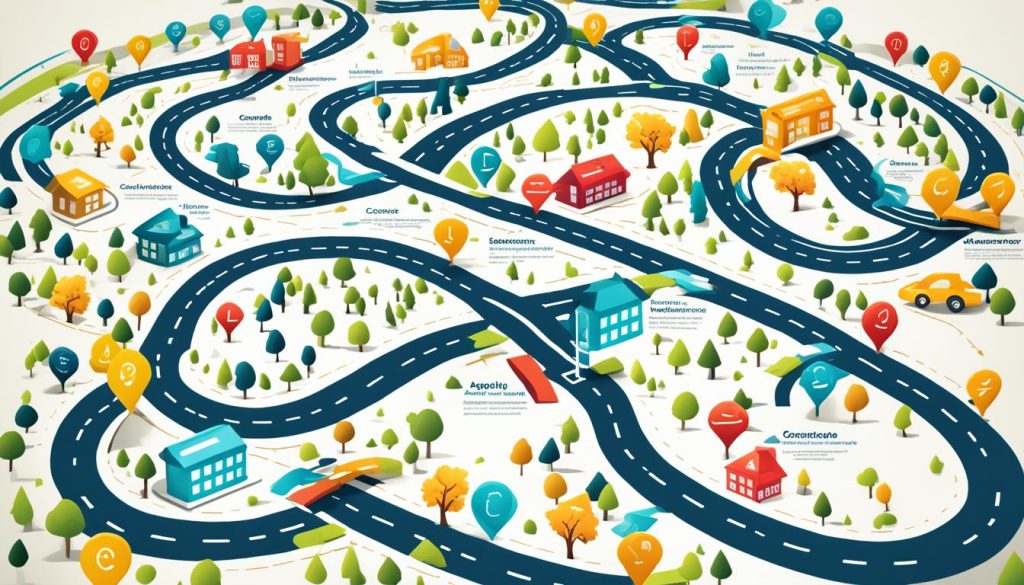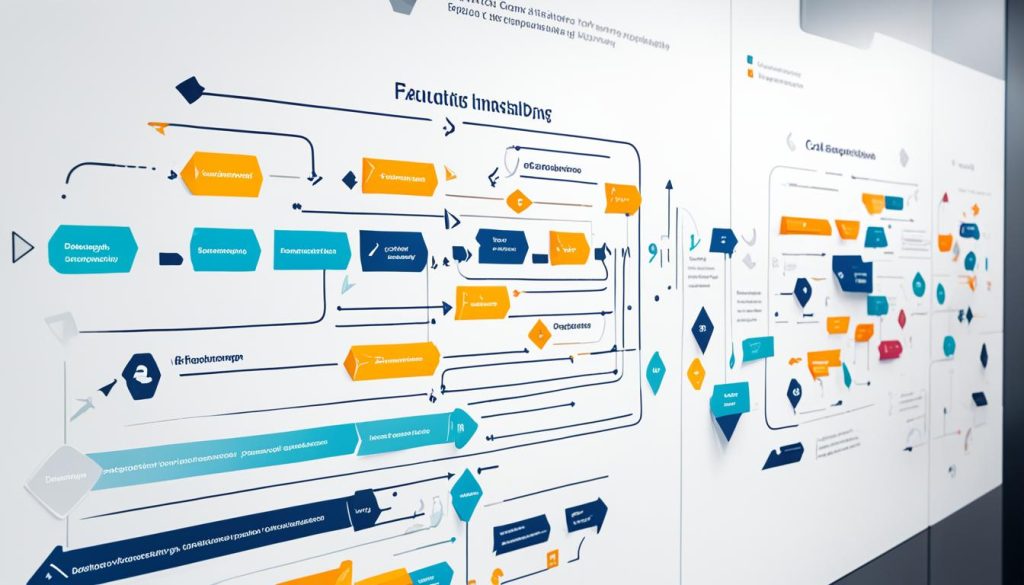- April 29, 2024
- Posted by: consultionz
- Category: Uncategorized

Agile project management brings together methods like scrum, kanban, and lean practices. This approach focuses on effective team work and fast planning. It uses tools made for agile projects.
This article explores key parts of agile project management and its role in success. We will look at scrum and kanban, two key ways of working under the agile umbrella. We’ll examine the teamwork needed and why quick planning is critical. Also, we will check out tools for agile projects and how they improve efficiency.
If you’re a seasoned project manager or just starting with agile, this article offers useful knowledge. It shows how agile project management can lead to success in business.
Why Agile Teams Need a Product Roadmap
Agile teams work best when they can adapt quickly, collaborate well, and provide value to customers. For this, having a clear product roadmap is essential. This roadmap acts as a strategic guide for the team.
It gives the team a specific direction and purpose. This helps in managing the complicated world of agile project management. The roadmap ensures everyone is on the same page and makes planning and decision-making easier.
With a product roadmap, teams focus on what matters most to the business. It shows the development journey of the product. This includes important goals and gives everyone a clear idea of what the team is working towards.
Sharing the roadmap is key in telling others about the product strategy. It helps in presenting plans clearly and getting support from important people. This promotes teamwork and ensures that everyone understands the goals.
Moreover, the roadmap makes everything transparent. It allows stakeholders to see progress and the team’s main tasks. This eases planning and lets the team adapt fast to new information. Incorporating feedback helps the team improve and deliver better to customers.
In short, a product roadmap is vital for agile teams. It guides their plans and helps in making smart choices. Also, it’s a great way to communicate with others in the organization and get their support. Teams that use a product roadmap well are more likely to succeed.
Traditional Roadmaps vs. Agile Roadmaps
In project management, traditional and agile roadmaps are quite different. Traditional ones follow a step-by-step plan focusing on detailed features. In contrast, agile roadmaps use a more flexible, iterative way. They look at big picture goals, not just specific features.
Traditional roadmaps mainly show what features a project will have. But, they often lack in sharing the project’s big vision and goals. This might make the to-do list too long for the team. As a result, progress could slow down.
Agile roadmaps, though, embrace change and new insights. They focus on the big goals, allowing quick shifts based on feedback or market shifts. This approach helps the team make smarter choices to move the project forward.
Agile roadmaps are great at sharing the project’s vision with everyone involved. They’re more than just a list of tasks. They make sure everyone understands and supports the project’s strategy and goals.
By focusing on top goals and themes, agile roadmaps help streamline choices. They make the project’s direction clear. This clarity boosts teamwork and helps everyone know what matters most.
While detailed, traditional roadmaps can struggle with changes. Agile roadmaps are more adaptable, helping teams respond fast and stay focused on key objectives.

The Agile Roadmapping Process: 6 Steps to Success
The agile roadmapping process is key to successful project management. It helps teams work towards business goals. By using these six steps, teams create a roadmap that adjusts to needs and brings maximum value.
1. Understand Business Objectives and Set Measurable KPIs
Start by clearly understanding what the organization wants to achieve. This includes targets like revenue and market share. Then, set measurable KPIs to check and improve progress.
2. Revisit the Product Vision
It’s important to ensure the product vision aligns with goals. This vision directs the team to focus on what truly matters. By tying the roadmap to the vision, teams aim to meet strategic goals.
3. Gather Customer Feedback
Listening to customers through feedback is crucial. This input can be from surveys or user tests. It helps teams understand what customers want. Then, they can focus on features that add real value.
4. Develop Themes for Prioritization
Themes set the direction for what’s most important. Teams choose these themes based on feedback and goals. This approach helps focus on adding significant product features.
5. Prioritize with Adaptive Planning
Deciding what comes first is a big part of agile roadmapping. Teams pick features to work on based on themes and customer feedback. Being flexible and adapting the plan is key.
6. Build and Iterate the Roadmap
Now, it’s time to create the roadmap with chosen features. This visual plan shows everyone where the project is headed. Keep in mind, the roadmap will need updates as things change.
Following these six steps lets organizations use agile roadmaps effectively. It connects their goals with business objectives, customer needs, and flexible planning. This makes the roadmap a powerful tool for achieving success.
Agile Roadmaps: A Lightweight Strategic Planning Tool
Agile roadmaps are key in strategic planning, offering a light and flexible way to show a project’s big themes and deadlines. They are different from traditional maps, focusing more on the big picture and what adds real value to the business.
These roadmaps keep everyone on the same page. They make sure both co-workers and partners know where the project is heading. By focusing on what’s best for the customer and the business, agile roadmaps highlight delivering real value.
They are great for the agile way of working. By showing what’s planned and why it’s important, they guide teams. This turns into a way to talk about what to do first, with a focus on what matters most to the customer and the business.
The Role of Agile Roadmaps in Strategic Planning
Agile roadmaps paint a clear picture of the project’s mission, goals, and what success looks like. This helps teams work towards delivering value and meeting their business goals.
They put the customer and project’s success at the forefront. Teams decide what to do first based on how it’ll affect the customer and the project. This way, everyone’s work helps reach clear, real outcomes.
The clarity they bring is key for teamwork. Agile roadmaps make sure everyone knows how the project is doing and where it’s headed. This open view promotes clear talk, trust, and responsibility among team members, leading to project success.

Overall, agile roadmaps are tools that help teams plan well yet stay flexible and adaptable. They focus on business targets, clear communication, and what’s best for the customer. This way, they keep projects on course, delivering meaningful results.
What Does an Agile Roadmap Look Like?
An agile roadmap’s look changes based on how a company plans and what they like visually. For startups, it’s often theme-based roadmaps or time-based roadmaps. Big companies might mix short-term and long-term plans. It shows themes, big tasks, deadlines, and short work periods in a way each group understands.
To show where a project is headed and how it’s doing, agile roadmaps are shown in different styles. This could be through charts or timelines. The main point is to give people a quick and clear look at the project’s big steps and final goals. This way, everyone involved can easily see if the project is going well and plan the next steps.
Types of Agile Roadmaps
- Theme-based roadmaps: These are all about the main themes or focus areas of the project. They show the big picture goals clearly. This lets the project team focus their work on these main themes.
- Time-based roadmaps: These show the project’s time line and when its parts will be ready. It helps teams use their time and effort wisely. Everyone can see when each important step will be finished.
- Progress-based roadmaps: These track how the project is doing over time. They show if things are on track or if there are issues. This helps everyone see the project’s progress clearly.
How an agile roadmap looks should match the company’s aims and communication style. It should clearly show the project’s goals and how it’s doing. This makes working together and making choices easier and more successful.
How to Create an Agile Roadmap
Creating an agile roadmap is key to an agile project’s success. It shows the team’s goals and what they want to achieve. With a focus on best practices, teams can craft an agile roadmap that works well.
Gather Stakeholder Input and Focus on Goals and Outcomes
Start by hearing from key stakeholders when making this roadmap. Learn what they value and expect, and connect the roadmap with the big business goals. It’s vital to set clear goals and outcomes for the team to meet. This keeps the roadmap in line with the organization’s goals.
Create a Coherent Story
An agile roadmap should make sense and follow the product’s growth. It outlines important steps, big projects, and features on the way. But, it must focus on what’s really needed to support the overall plan. This way, the roadmap is clear and convincing without extra or less useful steps.
Secure Stakeholder Buy-In
Getting stakeholders to support the agile roadmap is crucial. Keep stakeholders involved while creating it by asking for their ideas and dealing with their worries. This makes the roadmap something they’re committed to, which helps its success.
Make the Roadmap Measurable
To know if you’re doing well, make sure the roadmap’s goals are measurable. Identify KPIs that match what the roadmap aims to do. These stats show how the team is doing and keep the roadmap on track.
Regularly Review and Update
An agile roadmap needs to change as the project does. Always review and update based on new progress, feedback, and info. Have regular meetings to check how the roadmap matches the project’s changing needs. Keep it up to date and focused by changing goals and steps as needed.
Following these steps helps teams make a roadmap that fits the project’s big plan, gets everyone on board, and is easy to track. By always improving and updating it, the roadmap stays useful as a guide for the project’s entire journey.

What is Agile Project Management?
Agile project management is a clever way to develop software. It’s all about being flexible and working as a team. This method focuses on making small, constant improvements and embracing change quickly.
It’s used because software needs to adapt to changing needs. And, it aims to make sure the customer gets the most value out of it quickly. Teams follow methods like Scrum or Kanban to stay close, react fast, and improve always.
Agile Project Management Frameworks and Methodologies
Agile project management is about using different methods to get things done fast and well. It lets teams change plans quickly, making it easier to do the job right. This way, teams can work in a style that fits the project’s needs.
Scrum
Scrum is a top choice for managing projects in an agile way. It focuses on working together, being open, and improving step by step. Scrum teams work in short bursts called sprints, tackling tasks together.
Kanban
Kanban is another effective method that centers on seeing the work and controlling how much is done at once. With a Kanban board, teams track their tasks, spot problems, and move more smoothly through their work.
Hybrid Approaches
Hybrid methods blend different agile techniques to meet specific project needs. This lets teams pick the best strategies from various systems. They can design their own method that boosts output and success.
Lean
Lean aims to cut out unnecessary steps and increase value without delay. It gets rid of tasks that don’t help, lessens waiting times, and fine-tunes how work gets done. The focus is on delivering outstanding results.
XP (Extreme Programming)
Extreme Programming (XP) is all about open talks, keeping things simple, and acting on feedback quickly. It uses methods like pair coding, writing tests first, and regularly putting code together. This ensures the end work is of high quality.
Crystal
Crystal methods put people and how they work together above everything else. It knows that not all projects are the same: some need more rules, some less. So, it offers a way for teams to mix rules as they see fit for their project.
Agile frameworks and methods are key in today’s quick business world. They give teams the freedom to change while always aiming to be better. With these approaches, teams can keep up and stay ahead in their industry.
Conclusion
Agile project management helps teams work better to get things done quickly and meet changing needs. It’s all about using the right plans and getting team members to work well together. Methods like Scrum and Kanban help teams stay close-knit, adapt quickly, and get better all the time.
It’s important to keep trying new things to stay ahead in today’s business world. Teams need to constantly improve what they do. This way, they make sure they’re giving their customers the best they can offer. Agile lets companies be quick on their feet and never fall behind.
In the end, using agile helps businesses get more done in less time. Teams that keep making their processes better do great work. Agile means being able to handle the many challenges businesses face nowadays. It keeps them at the top of their game.

